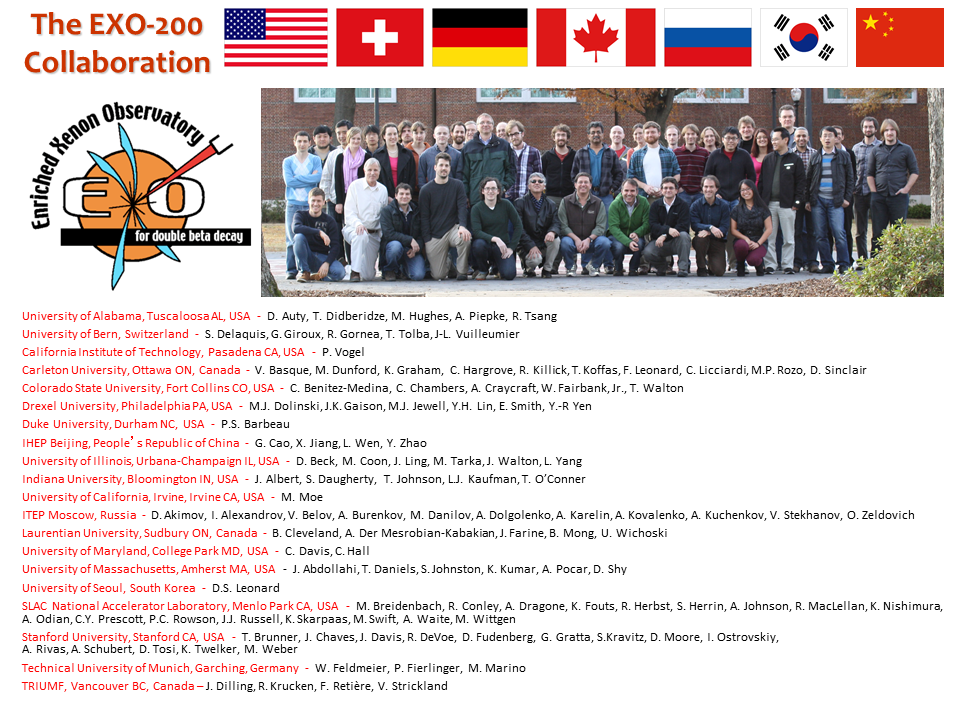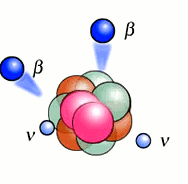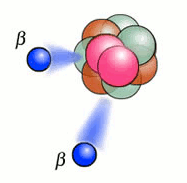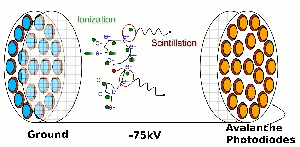
About the Experiment
EXO is an experiment looking for neutrinoless double beta decay in the 136 isotope of xenon. The experiment currently consists of two facets:
EXO is an experiment looking for neutrinoless double beta decay in the 136 isotope of xenon. The experiment currently consists of two facets:
- EXO-200, a 200-kilogram prototype experiment currently operating at WIPP. It has measured for the first time the two-neutrino mode of double beta decay of Xenon 136. It has also set the most stringent limit on the rate of neutrinoless double beta decay. It continues to collect data in order to improve on this limit or potentially discover the decay.
- nEXO, ("next EXO"), a tonne scale experiment using Xenon 136 to search for neutrinoless double beta decay. The collaboration is undergoing extensive R&D to design the xenon detector and a way to "tag" the barium daughter ion produced by the decay in order to eliminate all backgrounds.
Our Collaboration
 The project involves scientists from
The project involves scientists from
 The project involves scientists from
The project involves scientists from
- University of Alabama
- Universität Bern
- Caltech
- Carleton University
- Colorado State University
- Drexel University
- Duke University
- IHEP
- Indiana University
- UC Irvine
- Institute of Basic Science (Republic of Korea)
- ITEP (Moscow)
- Laurentian University
- McGill University
- University of Erlangen-Nuremberg
- University of Illinois at Urbana-Champaign
- University of Maryland
- University of Massachusetts - Amherst
- University of North Carolina Wilmington
- University of South Dakota
- SLAC National Accelerator Laboraotory
- Stanford University
- Stony Brook University
- Technische Universität München
- TRIUMF
- Yale University
Neutrinoless Double Beta Decay
Neutrinoless double beta decay is a special case of beta decay. Beta decay is a common form of nuclear decay which occurs when a neutron in an unstable nucleus emits an electron and an antineutrino and becomes a proton. Double beta decay occurs when a nucleus is energetically
or spin forbidden to decay through single beta decay. While it
has been predicted to exist for a long time, the long half-life makes it difficult to observe.
Double beta decay was only first observed in 1986. Many isotopes undergo double beta decay,
including xenon 136. EXO-200 was the first experiment to observe this decay in xenon.
In normal double beta decay, two electrons and two
antineutrinos are ejected from the nucleus when two
neutrons become protons. The half-lives of double beta
decay isotopes are very long, above 1020 years. This is
more than a billion times longer than the age of the
universe! So if you started with 8 billion atoms that can
undergo double beta decay at the beginning of the
universe, you would expect about 1 to have decayed by now.
Double beta decay occurs when a nucleus is energetically
or spin forbidden to decay through single beta decay. While it
has been predicted to exist for a long time, the long half-life makes it difficult to observe.
Double beta decay was only first observed in 1986. Many isotopes undergo double beta decay,
including xenon 136. EXO-200 was the first experiment to observe this decay in xenon.
In normal double beta decay, two electrons and two
antineutrinos are ejected from the nucleus when two
neutrons become protons. The half-lives of double beta
decay isotopes are very long, above 1020 years. This is
more than a billion times longer than the age of the
universe! So if you started with 8 billion atoms that can
undergo double beta decay at the beginning of the
universe, you would expect about 1 to have decayed by now.
 Neutrinoless double beta decay has not yet been seen, but
some theories predict it. It is like normal double beta
decay, but because of special properties of the neutrino,
no neutrinos would be emitted from the nucleus. The electrons
would carry all the energy of the decay, unlike normal double
beta decay, in which the antineutrinos carry away energy. Thus, neutrinoless
double beta decay has a unique, observable signature. In order
for this to occur, the neutrino would have to be its own
antiparticle. If neutrinos are their own antiparticles, which
are known as "Majorana" particles, then this admits many elegant
theories to explain how neutrinos acquire mass and why their mass
is so much smaller than any other particle we know.
We want to see neutrinoless double beta decay for two reasons. First,
we don't know if the neutrino is its own antiparticle or not, and
seeing it would answer this question for sure. Second, we don't know
the exact mass of the neutrino and a measurement of the neutrinoless
double beta decay half life would allow us to measure the neutrino
mass. Even if we don't see neutrinoless double beta decay, a limit on
the half life places a limit on the neutrino mass.
If you're still curious, Physics World has a nice
article on neutrinoless double
beta decay that is more detailed, but still accessible
to a lay person.
Neutrinoless double beta decay has not yet been seen, but
some theories predict it. It is like normal double beta
decay, but because of special properties of the neutrino,
no neutrinos would be emitted from the nucleus. The electrons
would carry all the energy of the decay, unlike normal double
beta decay, in which the antineutrinos carry away energy. Thus, neutrinoless
double beta decay has a unique, observable signature. In order
for this to occur, the neutrino would have to be its own
antiparticle. If neutrinos are their own antiparticles, which
are known as "Majorana" particles, then this admits many elegant
theories to explain how neutrinos acquire mass and why their mass
is so much smaller than any other particle we know.
We want to see neutrinoless double beta decay for two reasons. First,
we don't know if the neutrino is its own antiparticle or not, and
seeing it would answer this question for sure. Second, we don't know
the exact mass of the neutrino and a measurement of the neutrinoless
double beta decay half life would allow us to measure the neutrino
mass. Even if we don't see neutrinoless double beta decay, a limit on
the half life places a limit on the neutrino mass.
If you're still curious, Physics World has a nice
article on neutrinoless double
beta decay that is more detailed, but still accessible
to a lay person.
Neutrinoless double beta decay is a special case of beta decay. Beta decay is a common form of nuclear decay which occurs when a neutron in an unstable nucleus emits an electron and an antineutrino and becomes a proton.
 Double beta decay occurs when a nucleus is energetically
or spin forbidden to decay through single beta decay. While it
has been predicted to exist for a long time, the long half-life makes it difficult to observe.
Double beta decay was only first observed in 1986. Many isotopes undergo double beta decay,
including xenon 136. EXO-200 was the first experiment to observe this decay in xenon.
In normal double beta decay, two electrons and two
antineutrinos are ejected from the nucleus when two
neutrons become protons. The half-lives of double beta
decay isotopes are very long, above 1020 years. This is
more than a billion times longer than the age of the
universe! So if you started with 8 billion atoms that can
undergo double beta decay at the beginning of the
universe, you would expect about 1 to have decayed by now.
Double beta decay occurs when a nucleus is energetically
or spin forbidden to decay through single beta decay. While it
has been predicted to exist for a long time, the long half-life makes it difficult to observe.
Double beta decay was only first observed in 1986. Many isotopes undergo double beta decay,
including xenon 136. EXO-200 was the first experiment to observe this decay in xenon.
In normal double beta decay, two electrons and two
antineutrinos are ejected from the nucleus when two
neutrons become protons. The half-lives of double beta
decay isotopes are very long, above 1020 years. This is
more than a billion times longer than the age of the
universe! So if you started with 8 billion atoms that can
undergo double beta decay at the beginning of the
universe, you would expect about 1 to have decayed by now.
 Neutrinoless double beta decay has not yet been seen, but
some theories predict it. It is like normal double beta
decay, but because of special properties of the neutrino,
no neutrinos would be emitted from the nucleus. The electrons
would carry all the energy of the decay, unlike normal double
beta decay, in which the antineutrinos carry away energy. Thus, neutrinoless
double beta decay has a unique, observable signature. In order
for this to occur, the neutrino would have to be its own
antiparticle. If neutrinos are their own antiparticles, which
are known as "Majorana" particles, then this admits many elegant
theories to explain how neutrinos acquire mass and why their mass
is so much smaller than any other particle we know.
We want to see neutrinoless double beta decay for two reasons. First,
we don't know if the neutrino is its own antiparticle or not, and
seeing it would answer this question for sure. Second, we don't know
the exact mass of the neutrino and a measurement of the neutrinoless
double beta decay half life would allow us to measure the neutrino
mass. Even if we don't see neutrinoless double beta decay, a limit on
the half life places a limit on the neutrino mass.
If you're still curious, Physics World has a nice
article on neutrinoless double
beta decay that is more detailed, but still accessible
to a lay person.
Neutrinoless double beta decay has not yet been seen, but
some theories predict it. It is like normal double beta
decay, but because of special properties of the neutrino,
no neutrinos would be emitted from the nucleus. The electrons
would carry all the energy of the decay, unlike normal double
beta decay, in which the antineutrinos carry away energy. Thus, neutrinoless
double beta decay has a unique, observable signature. In order
for this to occur, the neutrino would have to be its own
antiparticle. If neutrinos are their own antiparticles, which
are known as "Majorana" particles, then this admits many elegant
theories to explain how neutrinos acquire mass and why their mass
is so much smaller than any other particle we know.
We want to see neutrinoless double beta decay for two reasons. First,
we don't know if the neutrino is its own antiparticle or not, and
seeing it would answer this question for sure. Second, we don't know
the exact mass of the neutrino and a measurement of the neutrinoless
double beta decay half life would allow us to measure the neutrino
mass. Even if we don't see neutrinoless double beta decay, a limit on
the half life places a limit on the neutrino mass.
If you're still curious, Physics World has a nice
article on neutrinoless double
beta decay that is more detailed, but still accessible
to a lay person.
EXO-200
EXO-200 is a prototype to develop techniques for working with liquid xenon in a time projection chamber (TPC). One possibility for tonne-scale EXO is a liquid TPC, so familiarity with EXO-200 technologies will contribute to the design of tonne-scale EXO. Additionally, EXO-200 provides a testing ground for developing and procuring extremely radiopure materials and removing backgrounds. EXO-200 has provided fundamental measurement of the double beta decay of xenon 136 and will provide improved limits on the rate of (or perhaps observation of) neutrinoless double beta decay. We are using 200 kg of liquid xenon (LXe) enriched to 80% of the 136 isotope
for EXO-200. The LXe fills our TPC vessel. When a particle deposits energy
in the liquid xenon, it ionizes the xenon atoms, knocking electrons off.
We apply an electric field to the xenon, which pushes many of the electrons
to wire grids where they are collected. The grid position provides a 2D location,
and the number of electrons is related to the event's energy. But some xenon ions recombine
with the electrons before they can drift away. This puts the xenon atoms into excited
states. When the excited atoms relax, they release ultraviolet light, known as scintillation, which we collect
on avalanche photodiodes (APDs). The time between the light signal (which comes nearly
instantaneously) and the ionization signal (which must drift and takes microsecond to
arrive) allows us to reconstruct the full 3D location of the event when combined with
the 2D position from the wire grids. Furthermore, the amount of light is also related
to the event's energy. Combining the ionization and light signals allows a better
energy menasurement than using either signal on its own.
We are using 200 kg of liquid xenon (LXe) enriched to 80% of the 136 isotope
for EXO-200. The LXe fills our TPC vessel. When a particle deposits energy
in the liquid xenon, it ionizes the xenon atoms, knocking electrons off.
We apply an electric field to the xenon, which pushes many of the electrons
to wire grids where they are collected. The grid position provides a 2D location,
and the number of electrons is related to the event's energy. But some xenon ions recombine
with the electrons before they can drift away. This puts the xenon atoms into excited
states. When the excited atoms relax, they release ultraviolet light, known as scintillation, which we collect
on avalanche photodiodes (APDs). The time between the light signal (which comes nearly
instantaneously) and the ionization signal (which must drift and takes microsecond to
arrive) allows us to reconstruct the full 3D location of the event when combined with
the 2D position from the wire grids. Furthermore, the amount of light is also related
to the event's energy. Combining the ionization and light signals allows a better
energy menasurement than using either signal on its own.
 The TPC vessel is contained within a cryostat system to help keep the
xenon at liquid temperature. The vessel is contained in a volume of
HFE-7000, a synthetic fluid that is liquid from room temperature down to LXe temperatures.
The HFE is within a large copper cryostat, which is then inside another coper cryostat with a vacuum
gap in between for insulation. The cryostat is shielded with lead and contained in a
class-100 cleanroom located 2150 ft underground at the Department of Energy's
Waste Isolation Pilot Plant. All of this is necessary to shield from radioactive backgrounds and cosmic rays.
On top of that, materials contained within the lead have been extensively counted for
radiopurity. The materials are low in radioactive isotopes and contamination.
The majority of the material is ultrapur, copper, teflon, phosphorbronze, and acrylic.
The TPC vessel is contained within a cryostat system to help keep the
xenon at liquid temperature. The vessel is contained in a volume of
HFE-7000, a synthetic fluid that is liquid from room temperature down to LXe temperatures.
The HFE is within a large copper cryostat, which is then inside another coper cryostat with a vacuum
gap in between for insulation. The cryostat is shielded with lead and contained in a
class-100 cleanroom located 2150 ft underground at the Department of Energy's
Waste Isolation Pilot Plant. All of this is necessary to shield from radioactive backgrounds and cosmic rays.
On top of that, materials contained within the lead have been extensively counted for
radiopurity. The materials are low in radioactive isotopes and contamination.
The majority of the material is ultrapur, copper, teflon, phosphorbronze, and acrylic.
EXO-200 is a prototype to develop techniques for working with liquid xenon in a time projection chamber (TPC). One possibility for tonne-scale EXO is a liquid TPC, so familiarity with EXO-200 technologies will contribute to the design of tonne-scale EXO. Additionally, EXO-200 provides a testing ground for developing and procuring extremely radiopure materials and removing backgrounds. EXO-200 has provided fundamental measurement of the double beta decay of xenon 136 and will provide improved limits on the rate of (or perhaps observation of) neutrinoless double beta decay.
 We are using 200 kg of liquid xenon (LXe) enriched to 80% of the 136 isotope
for EXO-200. The LXe fills our TPC vessel. When a particle deposits energy
in the liquid xenon, it ionizes the xenon atoms, knocking electrons off.
We apply an electric field to the xenon, which pushes many of the electrons
to wire grids where they are collected. The grid position provides a 2D location,
and the number of electrons is related to the event's energy. But some xenon ions recombine
with the electrons before they can drift away. This puts the xenon atoms into excited
states. When the excited atoms relax, they release ultraviolet light, known as scintillation, which we collect
on avalanche photodiodes (APDs). The time between the light signal (which comes nearly
instantaneously) and the ionization signal (which must drift and takes microsecond to
arrive) allows us to reconstruct the full 3D location of the event when combined with
the 2D position from the wire grids. Furthermore, the amount of light is also related
to the event's energy. Combining the ionization and light signals allows a better
energy menasurement than using either signal on its own.
We are using 200 kg of liquid xenon (LXe) enriched to 80% of the 136 isotope
for EXO-200. The LXe fills our TPC vessel. When a particle deposits energy
in the liquid xenon, it ionizes the xenon atoms, knocking electrons off.
We apply an electric field to the xenon, which pushes many of the electrons
to wire grids where they are collected. The grid position provides a 2D location,
and the number of electrons is related to the event's energy. But some xenon ions recombine
with the electrons before they can drift away. This puts the xenon atoms into excited
states. When the excited atoms relax, they release ultraviolet light, known as scintillation, which we collect
on avalanche photodiodes (APDs). The time between the light signal (which comes nearly
instantaneously) and the ionization signal (which must drift and takes microsecond to
arrive) allows us to reconstruct the full 3D location of the event when combined with
the 2D position from the wire grids. Furthermore, the amount of light is also related
to the event's energy. Combining the ionization and light signals allows a better
energy menasurement than using either signal on its own.
 The TPC vessel is contained within a cryostat system to help keep the
xenon at liquid temperature. The vessel is contained in a volume of
HFE-7000, a synthetic fluid that is liquid from room temperature down to LXe temperatures.
The HFE is within a large copper cryostat, which is then inside another coper cryostat with a vacuum
gap in between for insulation. The cryostat is shielded with lead and contained in a
class-100 cleanroom located 2150 ft underground at the Department of Energy's
Waste Isolation Pilot Plant. All of this is necessary to shield from radioactive backgrounds and cosmic rays.
On top of that, materials contained within the lead have been extensively counted for
radiopurity. The materials are low in radioactive isotopes and contamination.
The majority of the material is ultrapur, copper, teflon, phosphorbronze, and acrylic.
The TPC vessel is contained within a cryostat system to help keep the
xenon at liquid temperature. The vessel is contained in a volume of
HFE-7000, a synthetic fluid that is liquid from room temperature down to LXe temperatures.
The HFE is within a large copper cryostat, which is then inside another coper cryostat with a vacuum
gap in between for insulation. The cryostat is shielded with lead and contained in a
class-100 cleanroom located 2150 ft underground at the Department of Energy's
Waste Isolation Pilot Plant. All of this is necessary to shield from radioactive backgrounds and cosmic rays.
On top of that, materials contained within the lead have been extensively counted for
radiopurity. The materials are low in radioactive isotopes and contamination.
The majority of the material is ultrapur, copper, teflon, phosphorbronze, and acrylic.